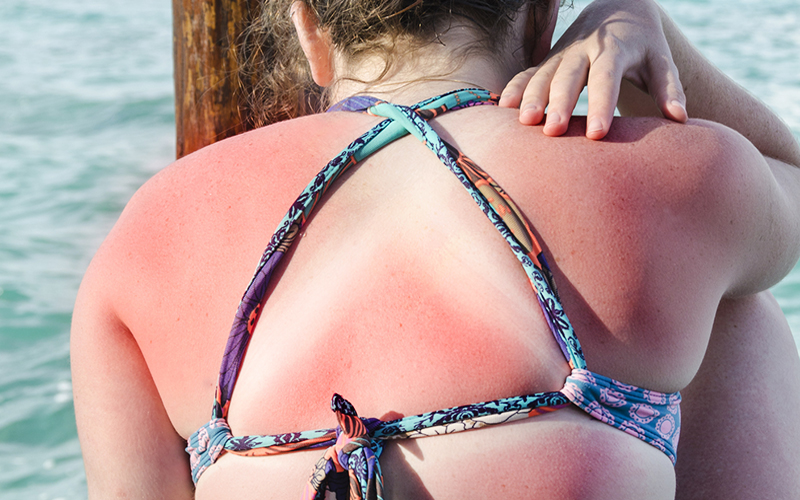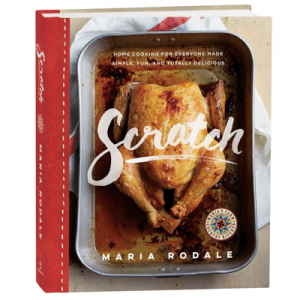
by the editors of Prevention magazine
Your day of summer fun is winding down and what do you know? You got burned and now you need a sunburn remedy.
You know that UV exposure can cause skin to age quickly and trigger skin cancer, but despite your best efforts to protect your skin from sun damage with sunscreen, you’ve gotten this painful, itching, and swelling sunburn. Try these home solutions recommended by experts to quell the discomfort and reverse the day’s rays.
1. Use compresses
Following a burn, skin is inflamed. Get sunburn relief with compresses dipped in either of the following substances:
- Cold water. Use either plain water from the faucet or add a few ice cubes, says Michael Schreiber, MD. Dip a cloth into the liquid and lay it over the burn. Repeat every few minutes as the cloth warms. Apply several times a day for a total of 10 to 15 minutes each.
- Witch hazel. Moisten a cloth with witch hazel, says Fredric Haberman, MD. This incredible astringent has been shown to have long-lasting anti-inflammatory relief. Apply often for temporary relief. For smaller areas, dip cotton balls into the liquid and gently wipe on.
Smart tip: You can also direct a fan on the area to heighten cooling.
2. Apply these foods
Common kitchen staples can be great sunburn soothers.
- Oatmeal. Wrap dry oatmeal in cheesecloth or gauze. Run cool water through it. Discard the oatmeal and soak compresses in the liquid. Apply every 2 to 4 hours.
- Fat-free milk. Mix 1 cup fat-free milk with 4 cups water, then add a few ice cubes. Apply compresses for 15 to 20 minutes; repeat every 2 to 4 hours.
- Cornstarch. Add enough water to cornstarch to make a paste. Apply directly to the sunburn.
- Lettuce. Boil lettuce leaves in water. Strain, then let the liquid cool several hours in the refrigerator. Dip cotton balls into the liquid and gently press or wipe onto irritated skin.
- Yogurt. Apply yogurt to all sunburned areas. Rinse off in a cool shower, then gently pat skin dry.
- Tea bags. If your eyelids are burned, apply tea bags soaked in cool water to decrease swelling and help relieve pain. Tea has tannic acid, which seems to ease sunburn pain.
3. Avoid soap
Don’t make it worse! Soap can dry and irritate skin with a sunburn.
Do not soak in soapy water. Likewise, stay away from bubble baths. If you must use soap, says Dr. Gossel, use only a mild brand and rinse it off very well. What you can do is take a cool bath, as an alternative to compresses. Add more water as needed to keep the temperature cool. Afterward, gently pat your skin dry with a clean towel. Do not rub your skin, or you’ll irritate it further. You can also add one of the following to reduce pain, itching, and inflammation.
- Vinegar. Mix 1 cup of white or apple cider vinegar into a tub of cool water, says Carl Korn, M.D. A great astringent, it soothes sunburn pain.
- Baking soda. Generously sprinkle baking soda into tepid bathwater, suggests Dr. Haberman. Instead of toweling off, let the solution dry on your skin. It is completely nontoxic, and it will soothe the pain.
4. Memorize these rules
While the memory of your sunburn is still painfully fresh, brush up on your sun sense with these tips from Norman Levine, MD.
- Apply a sunscreen about 30 minutes before going out, even if it’s overcast. (Harmful rays can penetrate cloud cover.) Don’t forget to protect your lips (try this lip balm with SPF), hands, ears, and the back of your neck. Reapply as necessary after swimming or perspiring heavily.
- Pick a sunscreen with an SPF between 15 and 30. Sunscreens with SPF 15 protect against 94% of the sun’s harmful rays, and those with SPF 30 protect against 97%. Also look for the ingredients zinc oxide, titanium dioxide, or avobenzone in your sunscreen. These block both ultraviolet A and B rays.
- Take extra care between the hours of 10 AM and 3 PM (11 AM and 4:00 PM, daylight saving time), when the sun is at its strongest.
- Wear protective clothing. Hats, tightly woven fabrics, and long sleeves help keep the sun off your skin.
5. Moisturize
You’ve really damaged your skin and now you need sunburn relief. It’s time to slather on lotion and begin repairs.
Soaks and compresses feel good and give temporary relief, says Rodney Basler, MD. But they can make your skin feel drier than before if you don’t apply moisturizing skin care immediately afterward. Pat yourself dry, then smooth on some bath oil. Let it soak in for a minute, then apply a moisturizing cream or lotion.
Smart Tip: Chill your moisturizer in the fridge for added relief.
6. Shop for the right skin care
Filter all the choices at the drugstore by looking for these key healers.
- Relieve with hydrocortisone: Soothe skin irritation and inflammation with a topical lotion, spray, or ointment containing 1% hydrocortisone, says Dr. Basler.
- Soothe with aloe: “We’re starting to see evidence in medical literature that aloe vera may really help wound healing,” says Dr. Basler. Simply break off a leaf and apply the juice. But test a small area first, he cautions, to make sure you’re not allergic to aloe.
- Guard against infection: If you have an infection or are worried that one will develop, use an OTC antibacterial ointment, says Dr. Schreiber.
- Numb with an anesthetic: If your burn is mild, an OTC anesthetic can relieve pain and itching, says Dr. Gossel. Aerosols are easier to apply than creams or ointments, but never spray them directly onto your face. Instead, put some on a piece of gauze or a cotton pad and pat it on your face to avoid contact with your eyes.
7. Go to the freezer
Sunburns hurt! Follow your urge to reach for something cold, just make sure to do it right. An ice pack can also provide relief if the burn is mild. Wrap it in a damp cloth and hold it over the sunburn. Improvise, if necessary, says Dr. Haberman. “You could even take a bag of frozen peas, for instance, and use that. But make sure to wrap it first so that you’re not placing the icy package directly against your skin.”
8. Eat and drink!
Put the right stuff in your body to aid your skin-saving efforts. It’s a good idea to drink lots of water to help counteract the drying effects of a sunburn, says Dr. Gossel. The water in fruit counts, too. One large wedge of watermelon provides 9 oz—more than 1 full cup—of water. (It’s also an excellent source of cancer-fighting lycopene.) Other fruit standouts: 1 cup diced honeydew (5.4 oz of water); 1 cup sliced beets (5.2 oz of water); 1 cup cubed cantaloupe (5.1 oz of water). Eat lightly but wisely, Dr. Gossel adds. A balanced diet helps provide the nutrients your skin needs to regenerate.
9. Take it easy
Sleeping on a sunburn can be challenging, but you need rest for your body to recover. Try sprinkling a natural powder on your sheets to decrease friction. An air mattress might also help you sleep more easily.
10. Beware of blisters
A sign of severe damage, blisters must be treated with care. If blisters develop, you have a pretty bad burn. If they bother you and they cover only a small area, you may carefully drain them, says Dr. Basler. But do not peel the top skin off; you’ll have less discomfort and danger of infection if air does not come in contact with sensitive nerve endings. To drain the fluid, first sterilize a needle by holding it over a flame. Then puncture the edge of the blister and press gently on the top to let the fluid come out. Do this three times in the first 24 hours, says Dr. Basler. Then leave the blisters alone.
Smart tip: If your legs are burned and your feet are swollen, elevate your legs above heart level to help stop the swelling, says Dr. Basler.
11. Question your medications
Find out if you’re photosensitive. We’re not asking if you like to have your picture taken. The question is whether certain drugs increase your sensitivity to the sun and lead to a burnlike dermatitis. Antibiotics, tranquilizers, and antifungal medications can cause reactions, says Dr. Basler. So can oral contraceptives, diuretics, drugs for diabetes, and even PABA-containing sunscreens. Always ask your doctor about potential side effects of any drugs you may be taking. Even common foods can trigger a bad reaction. “Two young women I know tried to lighten their hair with lime juice,” he says. “They didn’t realize what a potent photosensitizer lime juice can be until they developed terrible dermatitis every place the juice had run down their faces and arms.”
12. Wise up
Don’t make the same mistake twice. After you’ve gotten burned, it takes 3 to 6 months for your skin to return to normal, says Dr. Schreiber. “When you get a sunburn and the top layer of skin peels off, the newly exposed skin is more sensitive than ever. That means you’ll burn even faster than you did before if you’re not careful.” Be sensitive about your sun exposure and protect yourself with hats, clothing, and sunscreen such as Suntegrity Sunscreen for your face or Coola Sunscreen Spray SPF 30 or All Good Sport Sunscreen SPF 33 for all over.
Smart tip: You can still get UV rays through windows, so apply sunscreen even when you’re not planning activities outside.
Adapted from a story originally published on Prevention.




No comments yet.